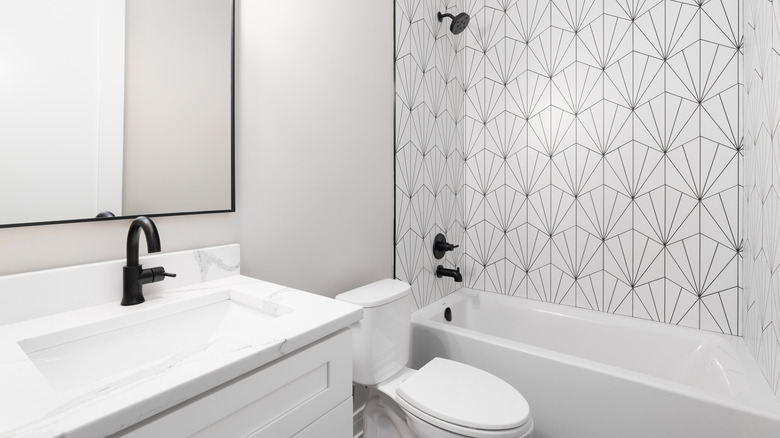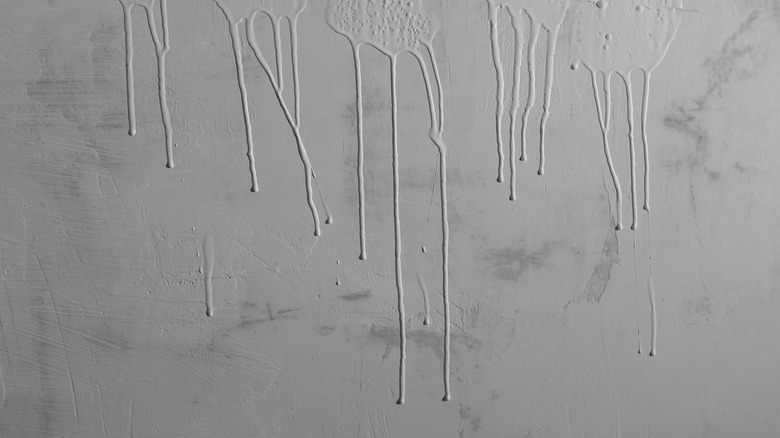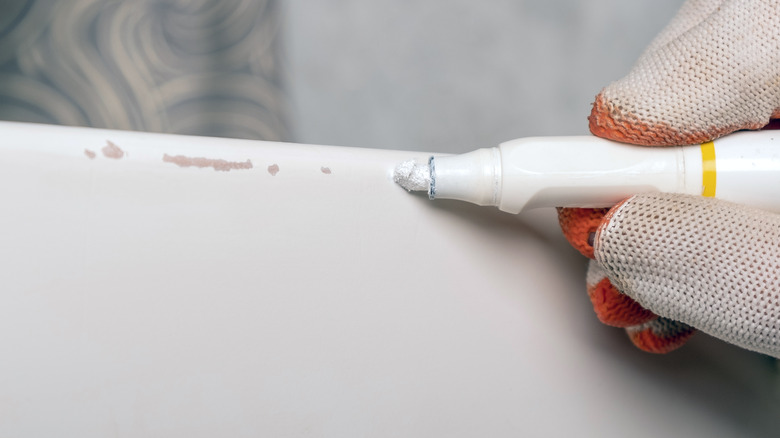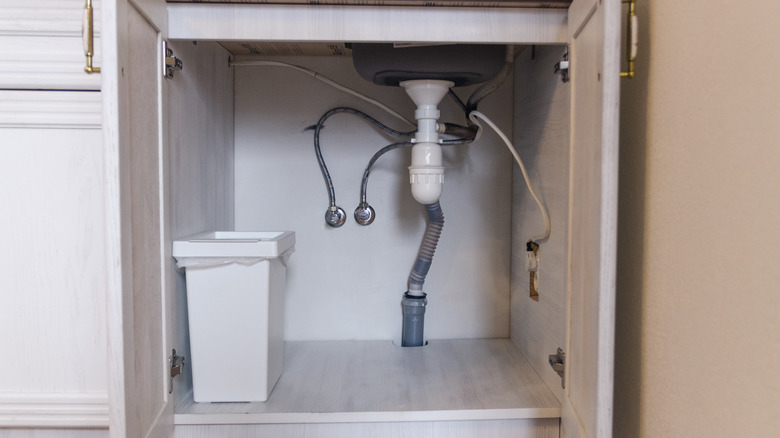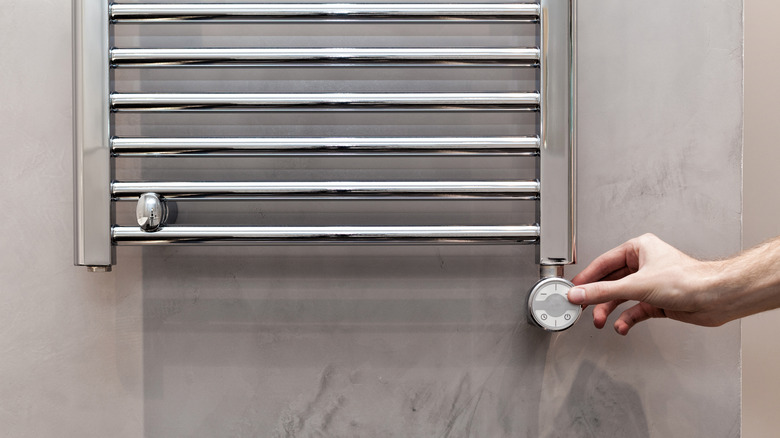5 Signs The Bathroom In Your New Home Was Poorly Flipped
Just a few years ago, signs of a flipped bathroom weren't even on the radar for prospective homeowners. In 2017, only about 5.7% of home sales were flipped, but that number has nearly doubled to 9.6% in 2022 (via The Motley Fool). Unfortunately, as house flipping has become a trendy investment scheme, so have cheaply renovated homes. According to CNBC, the average gross profit for home flippers in 2021 was $67,000. Of course, making such a great profit may require home flippers to cut some corners — especially in bathrooms.
Bathrooms can easily act as one of the most transparent spaces in a home. Previous homeowners would have used this room every day, and during that time, the bathtub, sink, toilet, and plumbing received a lot of wear and tear. Bathrooms are also susceptible to design trends from previous decades; case in point: the Pepto-pink tiled walls of the 1950s. When you're looking at a flipped home, everything may feel shiny, exciting, and new, but secrets could be lurking underneath all the fresh white paint. Here are the five key signs that indicate your bathroom was cheaply flipped.
1. Tawdry tiles
Outdated, cracked, or stained tiles can date and devalue the home, so flippers will typically replace the bathroom floor with something trendy, modern, and new. A new floor could even be a sign that there was once water damage under tiles. Water Damage Plus warns that water underneath bathroom tiles is usually caused by one of two things: old, worn grout or a water leak from misaligned or broken pipes. The new tile flooring may solve the first issue, but if broken pipes are the culprit, it will only mask them for a while.
Unfortunately, many flippers focus more on the initial aesthetic value than actual durability and flooring material quality. Watch out for cheap materials like locking laminate, peel-and-stick vinyl, or unsealed painted concrete in the bathroom. These flooring types may look glamorous at first, but they aren't sustainable in humid and wet environments long-term. A flipped bathroom could also have real, decent tile but poorly executed installation. Check the alignment of your tiles and the seams along your bathtub, toilet, and vanity. Are the edges poorly sealed? Are tiles cut at funny angles or spaced and grouted unevenly? Odd, small pieces around the bathtub with whole tiles near the door could indicate that the project was quickly rushed from one end to the other, a sure sign of a poorly flipped bathroom.
2. Sloppy painting
If you suspect your bathroom may have been cheaply flipped, another great place to look is on the walls, doors, and cabinetry. Paint is cheap, and a fresh coat of paint can hide a lot of unsavory details. Everyone has their own personal tastes in paint colors, but Home Reference warns that an unsightly or out-of-place wall color that doesn't fit the space could indicate a bad interior paint job. If the color itself seems fine, look closely at the corners, door frames, and edges where the wall meets the ceilings and floors. Do they look like they were neatly taped? Instead of taping, some painters quickly "cut" around the edges with a smaller brush, then apply sweeping coats with a roller. If this isn't done well or a second coat isn't applied, you may be able to see lines where one only coat was applied.
If the walls seem okay, take a closer look at your cabinets and vanity. The "landlord special" is not exclusive to rented homes, so watch out for gobs of paint where they shouldn't be. Check the corners to see if the painters took the time to remove doors from the hinges. Paint on the cabinet fixtures, wall outlets, or hardware can be an obvious sign of a cheap paint job.
3. Touched-up bathtub
Installing a new bathtub or shower can be expensive, so rather than replace the whole tub, many home flippers will choose to refinish or re-seal the existing one. A refinished bathtub isn't always a bad thing, but poorly refinished tubs can become a problem. Renovations Roofing & Remodeling Inc. recommends looking closely for bubbles, fading, and a rough or sticky bathtub texture, all signs that the refinishing was done cheaply or by non-professionals. A poorly refinished tub may be livable at first, but it is more prone to peeling, scratching, and chipping over time.
In general, a bathtub cannot be refinished more than once or twice, according to Maryland Tub & Tile. It's worth contacting the previous owner to determine how many times a bathtub or shower has already been refinished. If your bathroom has a tiled shower, look closely to ensure the tiles were installed and sealed correctly. As with any bathroom, but especially with a flipped bathroom, you'll need to check the drainage routes and faucets for leaks.
4. Problematic pipes
The biggest risk with flipped homes is that they may hide faulty systems under a pretty facade. Some flippers will only update the pipes you can see, so make sure your home inspector looks deeper into the issue. Professionals at Waypoint Property Inspection say that poorly installed flexible drain lines are one of the most obvious signs of a cheaply flipped home. In other cases, flippers may fail to replace old iron parts or even repaint exposed pipes to look newer.
If you haven't yet bought the home, ask the sellers for details about the pipes. When were they last inspected or repaired? Have there been any significant leaks or breaks in the past few years? Problems with old pipes can escalate to much more than a simple leak. A freshly painted or wallpapered wall behind the sink could be a sneaky way of disguising a mold problem. Water damage and mold growth are serious health and safety concerns that you have a right to know about.
5. Questionable additions
The devil is in the details, so beware of "luxury" finishes designed to distract you from the functional problems. Towel warmers, flawless countertops, jetted bathtubs, and brand-new fixtures can make a flipped bathroom seem like a dream at first. These luxury elements may be nice, but it's important to keep a clear head, especially if you know that the house has functional issues like outdated plumbing. Don't be afraid to inspect the flashy details in your bathroom too. Do the exhaust fan, towel warming rack, bathtub jets, and dimmable lights actually work? Were they installed correctly, and do they have any warranties?
Most importantly, don't let the shiny fixtures and new paint job drown out your other senses. Feel around the walls and under cabinets, and use your nose as much as your eyes. A damp, musty, or mildewy smell can be a key indicator that something is wrong. If you can smell mold, but you don't see it, Mold Pro Tips says it's crucial to call a professional as soon as possible. In some cases, flippers may even paint over mold growth to hide it from sight, but this does not kill the mold or its spores. If you can smell mold, it likely won't be long until it grows into a serious problem, damaging your home and endangering your health.
